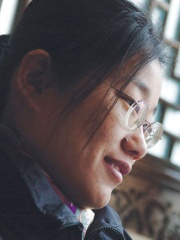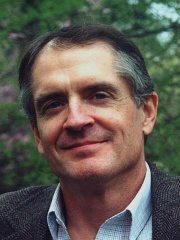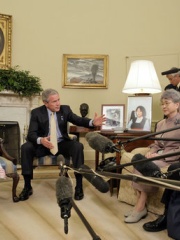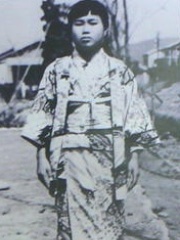
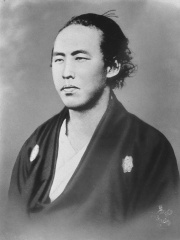
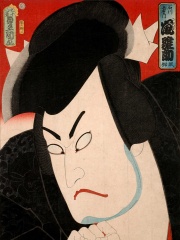
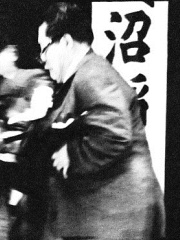
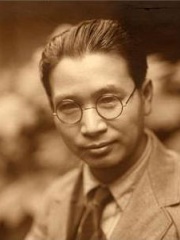
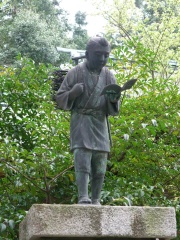
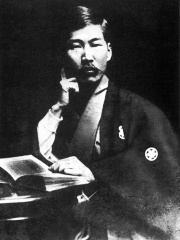
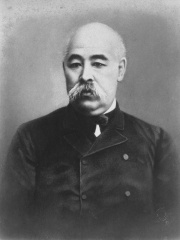
The Most Famous
SOCIAL ACTIVISTS from Japan
This page contains a list of the greatest Japanese Social Activists. The pantheon dataset contains 840 Social Activists, 15 of which were born in Japan. This makes Japan the birth place of the 11th most number of Social Activists behind Iran, and South Africa.
Top 10
The following people are considered by Pantheon to be the top 10 most legendary Japanese Social Activists of all time. This list of famous Japanese Social Activists is sorted by HPI (Historical Popularity Index), a metric that aggregates information on a biography's online popularity. Visit the rankings page to view the entire list of Japanese Social Activists.

1. Sadako Sasaki (1943 - 1955)
With an HPI of 74.55, Sadako Sasaki is the most famous Japanese Social Activist. Her biography has been translated into 49 different languages on wikipedia.
Sadako Sasaki (佐々木 禎子, Sasaki Sadako; January 7, 1943 – October 25, 1955) was a Japanese girl who became a victim of the atomic bombing of Hiroshima by the United States. She was two years of age when the bombs were dropped and was severely irradiated. She survived for another ten years, becoming one of the most widely known hibakusha—a Japanese term meaning "bomb-affected person". She is remembered through the story of the more than one thousand origami cranes she folded before her death. She died at the age of 12 on October 25, 1955, at the Hiroshima Red Cross Hospital.

2. Sakamoto Ryōma (1836 - 1867)
With an HPI of 73.79, Sakamoto Ryōma is the 2nd most famous Japanese Social Activist. His biography has been translated into 34 different languages.
Sakamoto Ryōma (坂本龍馬 or 坂本竜馬; 3 January 1836 – 10 December 1867) was a Japanese samurai, a shishi and influential figure of the Bakumatsu, and establishment of the Empire of Japan in the late Edo period. Sakamoto was a low-ranking samurai from the Tosa Domain on Shikoku and became an active opponent of the Tokugawa Shogunate after the end of Japan's sakoku isolationist policy. Under the alias Saitani Umetarō (才谷梅太郎), he worked against the Bakufu, the government of the Tokugawa shogunate, and was often hunted by their supporters and the Shinsengumi. Sakamoto advocated for democracy, Japanese nationalism, return of power to the Imperial Court, abolition of feudalism, and moderate modernization and industrialization of Japan. Sakamoto successfully negotiated the Satchō Alliance between the powerful rival Chōshū and Satsuma domains and united them against the Bakufu. Sakamoto was assassinated in December 1867 with his companion Nakaoka Shintarō, shortly before the Boshin War and the Meiji Restoration.

3. Ishikawa Goemon (1558 - 1594)
With an HPI of 67.88, Ishikawa Goemon is the 3rd most famous Japanese Social Activist. His biography has been translated into 24 different languages.
Ishikawa Goemon (石川 五右衛門, Ishikawa Goemon; Japanese pronunciation: [i.ɕi̥.ka.wa (|) ɡo.e.moɴ], August 24, 1558 – October 8, 1594) was the leader of a group of bandits during the Azuchi-Momoyama period in Japan. Over time, and especially during the Edo period (1603–1867), his life and deeds became a center of attention, and he became known as a legendary Japanese outlaw hero who stole gold and other valuables to give to the poor. He and his son were boiled alive in public after their failed assassination attempt on the Sengoku period warlord Toyotomi Hideyoshi. His legend lives on in contemporary Japanese popular culture, often giving him greatly exaggerated ninja skills.

4. Otoya Yamaguchi (1943 - 1960)
With an HPI of 66.10, Otoya Yamaguchi is the 4th most famous Japanese Social Activist. His biography has been translated into 30 different languages.
Otoya Yamaguchi (山口 二矢, Yamaguchi Otoya; 22 February 1943 – 2 November 1960) was a Japanese right-wing ultranationalist youth who assassinated Inejirō Asanuma, chairman of the Japan Socialist Party, on 12 October 1960. Yamaguchi rushed the stage and stabbed Asanuma with a wakizashi-like short sword while Asanuma was participating in a televised election debate at Hibiya Public Hall in Tokyo. Yamaguchi, who was 17 years of age at the time, had been a member of Bin Akao's far-right Greater Japan Patriotic Party, but had resigned earlier that year, just prior to the assassination. After being arrested and interrogated, Yamaguchi committed suicide while in a detention facility. Yamaguchi became a hero and a martyr to Japanese far-right groups, who as of 2022, have continued to hold commemorations to this day. Yamaguchi's actions inspired a number of copycat crimes, including the Shimanaka incident in 1961, and inspired Nobel Prize-winning novelist Kenzaburō Ōe's novellas Seventeen and Death of a Political Youth. A photograph of the Asanuma assassination taken by Japanese photojournalist Yasushi Nagao won World Press Photo of the Year for 1960 and the 1961 Pulitzer Prize.
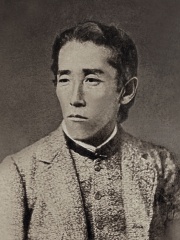
5. Itagaki Taisuke (1837 - 1919)
With an HPI of 61.95, Itagaki Taisuke is the 5th most famous Japanese Social Activist. His biography has been translated into 26 different languages.
Count Itagaki Taisuke (板垣 退助, 21 May 1837 – 16 July 1919) was a Japanese samurai, politician, and leader of the Freedom and People's Rights Movement (自由民権運動, Jiyū Minken Undō), which evolved into Japan's first political party, the Liberal Party (Jiyūtō). His activism in favour of a parliamentary democracy was a pivotal influence on the political development of Meiji Japan. A native of Tosa Domain, Itagaki was a leading figure in the Meiji Restoration and held a series of posts in the new government, including that of Councillor of State (参議, sangi). In 1873, he resigned from government after his proposal for a military expedition to Korea, a policy known as Seikanron, was rejected by the ruling oligarchy. After his resignation, Itagaki formed the Aikoku Kōtō (Public Party of Patriots), Japan's first political association, and launched a political movement aimed at establishing a representative assembly. He submitted a memorial to the government in 1874 calling for the creation of a national assembly, which, though initially dismissed, sparked a nationwide debate and is considered the foundational event of the Freedom and People's Rights Movement. Itagaki organized his political followers in his native Tosa into the Risshisha, and in 1881, he founded the Liberal Party (Jiyūtō), widely regarded as Japan's first modern political party. He survived an assassination attempt in 1882 and travelled to Europe the same year, deepening his exposure to Western political thought. After the Meiji Constitution was promulgated in 1889, Itagaki continued his political career, serving as Minister of Home Affairs in cabinets led by Itō Hirobumi and Ōkuma Shigenobu.

6. Toyohiko Kagawa (1888 - 1960)
With an HPI of 59.21, Toyohiko Kagawa is the 6th most famous Japanese Social Activist. His biography has been translated into 20 different languages.
Toyohiko Kagawa (賀川 豊彦, Kagawa Toyohiko; 10 July 1888 – 23 April 1960) was a Japanese Evangelical Christian pacifist, Christian reformer, and labour activist. Kagawa wrote, spoke, and worked at length on ways to employ Christian principles in the ordering of society and in cooperatives. His vocation to help the poor led him to live among them. He advocated for women's suffrage and promoted a peaceful foreign policy.

7. Ninomiya Sontoku (1787 - 1856)
With an HPI of 58.48, Ninomiya Sontoku is the 7th most famous Japanese Social Activist. His biography has been translated into 15 different languages.
Ninomiya Sontoku (二宮 尊徳; September 4, 1787 – November 17, 1856), also known as Ninomiya Kinjirō (二宮 金次郎), was a Japanese agriculturalist. He lost his parents when he was a boy, but through hard work and diligence, he rebuilt his fallen family at the age of 20. Later, he rebuilt approximately 600 villages and became a shogunate retainer. His ideas and actions were inherited as the Hōtokusha Movement.

8. Kōtoku Shūsui (1871 - 1911)
With an HPI of 58.40, Kōtoku Shūsui is the 8th most famous Japanese Social Activist. His biography has been translated into 20 different languages.
Kōtoku Denjirō (幸徳 傳次郎; November 5, 1871 – January 24, 1911), better known by the pen name Kōtoku Shūsui (Japanese: 幸徳 秋水; Japanese pronunciation: [koːtokɯ ɕɯːsɯi]), was a Japanese socialist and anarchist who played a leading role in introducing anarchism to Japan in the early 20th century. Historian John Crump described him as "the most famous socialist in Japan". He was a prominent figure in radical politics in Japan, opposing the Russo-Japanese War by founding the Heimin-sha group and its associated newspaper, Heimin Shinbun. Due to disregard for state press laws, the newspaper ceased publication in January 1905, and Kōtoku served five months in prison from February to July 1905. He subsequently left for the United States, spending November 1905 until June 1906 largely in California, and he came into contact with other prominent anarchist figures such as Peter Kropotkin. Upon his return, he contributed to a divide within the left-wing movement between moderate social democrats and the more radical advocates of direct action, the latter of whom he supported. The growth of the 'direct action' faction led to the banning of the Japan Socialist Party in February 1907, and is arguably the beginning of Japan's modern anarchist movement. He was one of the 12 accused who were executed for treason by the Japanese government in the High Treason Incident in 1911, under suspicion of involvement in a bomb plot to assassinate the Japanese Emperor Meiji.

9. Gotō Shōjirō (1838 - 1897)
With an HPI of 57.07, Gotō Shōjirō is the 9th most famous Japanese Social Activist. His biography has been translated into 19 different languages.
Count Gotō Shōjirō (後藤 象二郎; 13 April 1838 – 4 August 1897) was a Japanese samurai and politician during the Bakumatsu and early Meiji period of Japanese history. He was a leader of Freedom and People's Rights Movement (自由民権運動, jiyū minken undō) which would evolve into a political party.
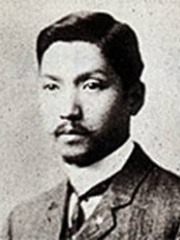
10. Ōsugi Sakae (1885 - 1923)
With an HPI of 55.84, Ōsugi Sakae is the 10th most famous Japanese Social Activist. His biography has been translated into 18 different languages.
Ōsugi Sakae (Japanese: 大杉 栄; 17 January 1885 – 16 September 1923) was a Japanese anarchist, writer, and social critic of the Taishō period. His thought centered on individualism, direct action, and the "expansion of the ego" as philosophical underpinnings for social and personal revolution. His advocacy of free love and his controversial personal life, which included simultaneous relationships with three women, led to a violent attack against him and his temporary ostracism from the socialist movement. Born into a military family, Ōsugi was expelled from military school for insubordination and turned to language studies and radical politics in Tokyo. After a series of prison terms between 1906 and 1910, which he considered his "real education," he emerged as a leading voice in the Japanese anarchist movement. Through his journals, such as Kindai shisō (Modern Thought) and Rōdō undō (The Labor Movement), he introduced the works of European thinkers like Peter Kropotkin, Georges Sorel, and Henri Bergson to Japan, synthesizing their ideas into his own philosophy. He became a key figure in the Japanese labor movement, advocating for syndicalism and workers' autonomy while strongly criticizing both state authority and the emerging Bolshevism. In the chaotic aftermath of the 1923 Great Kantō earthquake, Ōsugi, his partner and fellow anarchist Itō Noe, and his six-year-old nephew were arrested by a squad of military police led by Captain Amakasu Masahiko. They were beaten and strangled, their bodies disposed of in a well. Their murders, known as the Amakasu Incident, became a symbol of state violence against radicals during the period.
People
Pantheon has 15 people classified as Japanese social activists born between 1558 and 1978. Of these 15, 4 (26.67%) of them are still alive today. The most famous living Japanese social activists include Akira Amano, Jared Taylor, and Oliver Wood. The most famous deceased Japanese social activists include Sadako Sasaki, Sakamoto Ryōma, and Ishikawa Goemon.
Living Japanese Social Activists
Go to all RankingsAkira Amano
1973 - Present
HPI: 52.65
Jared Taylor
1951 - Present
HPI: 50.37
Oliver Wood
HPI: 43.77
Sayaka Osakabe
1978 - Present
HPI: 38.07
Deceased Japanese Social Activists
Go to all RankingsSadako Sasaki
1943 - 1955
HPI: 74.55
Sakamoto Ryōma
1836 - 1867
HPI: 73.79
Ishikawa Goemon
1558 - 1594
HPI: 67.88
Otoya Yamaguchi
1943 - 1960
HPI: 66.10
Itagaki Taisuke
1837 - 1919
HPI: 61.95
Toyohiko Kagawa
1888 - 1960
HPI: 59.21
Ninomiya Sontoku
1787 - 1856
HPI: 58.48
Kōtoku Shūsui
1871 - 1911
HPI: 58.40
Gotō Shōjirō
1838 - 1897
HPI: 57.07
Ōsugi Sakae
1885 - 1923
HPI: 55.84
Megumi Yokota
1964 - 1977
HPI: 53.41
Overlapping Lives
Which Social Activists were alive at the same time? This visualization shows the lifespans of the 7 most globally memorable Social Activists since 1700.

